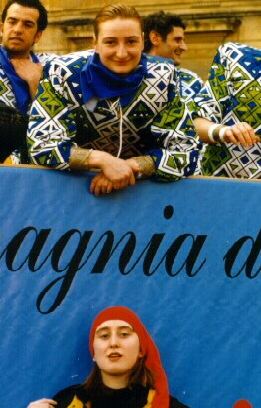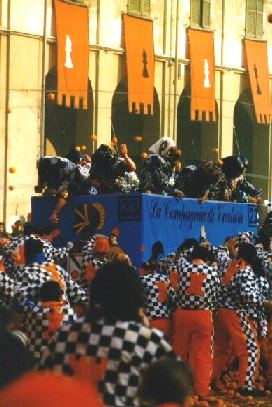History of the
Carnival of Ivrea
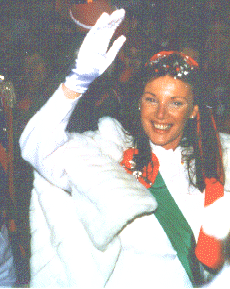 ((Photos by: me!!!!))
|
The Carnival of Ivrea is
a historical performance dated about two hundred years...
On Carnival's days, the "Eporediesi" (people
who live in Ivrea) become masters of the city. They get
around the leading figures of the performance, the "Mugnaia" and the
"Generale" and other people; they give start to a
beautiful show called THE BATTLE OF THE ORANGES
("Battaglia delle Arance"). A feature of this
carnival is the large period of this performance: from
the Epifania (January, 6) to the Wednesday of ash
(Mercoled́ delle ceneri).The event of this performance goes back to
1800's, when each districts of Ivrea celebrated the
Carnival on his own. The Napoleonic government, which
ruled Ivrea in those years, imposed the Carnivals to be
joing. It had been allowed to an eporediese citizen to
become Generale of the napoleonic army and to join of
"Aiutanti di Campo e Ufficiali di Stato
Maggiore" (Aides-de-camp and Line officers).
In thas period started
the use to wear the "Berretto frigio" (cap
frigio), symbol of the French Revolution. The spirit of
freedom of the Eporediesi has origins already in 1194
years.
|
Fallowing the legend of those
times, it has been told that the tyrant "conte Ranieri di
Biandrate" pretended the "
jus primae noctis
", i.e. to
spend the first night of wedding with all the brides. This was
also the destiny of Violetta, the daughter of a miller, that
rebelled to the pretentionses of the tyrant. Violetta cut his
head with a dagger hidden under her nuptial dress. Then she show
the tyrant's head to the eporediese population joint by the
"Castellazzo". Therefore the "Mugnaia"
incited a popular revolt that drove to the destruction of the
"Castellazzo".
The Battle of the Oranges is one
of the most beautiful performance of the popular insurrection:
the "aranceri", wich are teams of people figthing on
foot, (represented from 9 team: "Asso di Picche",
"Morte", "Scacchi", "Arduini",
"Diavoli", "Mercenari", "Pantere",
"Credendari" and "Tuchini") represent the
population in fighting against the people on the waggon, symbol
of the tyrant's guards.
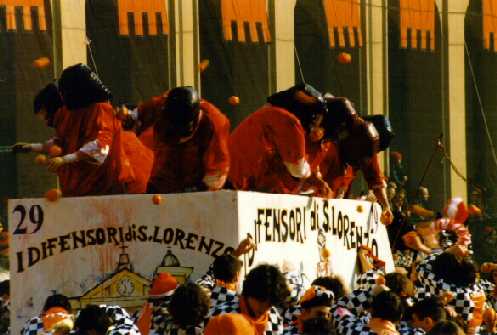 ((Photos by:
me!!!!))
|
CALENDAR OF THE CARNIVAL:
MORNING OF THE EPIFANY (January,
6) = "Pifferi" and "Tamburi" announces in the
ways and in a public squares of Ivrea the beginning of the
Carnival. They calls all people to the presentation of the new
"Generale".
Then the procession to the chapel of the Three Wise Kings on the
"Monte Stella".
THE TWO SUNDAYS
BEFORE THE CARNIVAL THURSDAY = it carries out the
"alzata degli Abbà", the young protagonist of the city
quarter, introduced to the population from the balconies each in
his own quarters...
"GIOVED̀
GRASSO" (Carnival Thursday) = in the hall of
honor of the Civic Palace, the Mayor delivers wraps tricolour to
the "Generale".
"Generale" assumes the full powers on the city: then it
reads the "Proclama" from the Balcony. The day will be
concluded, after the visit to the Bishop of Ivrea, with masked
ball in "Piazza Ottinetti" and "Piazza di
Città", the two most important squares of the city.
Ballo in maschera - look the photo
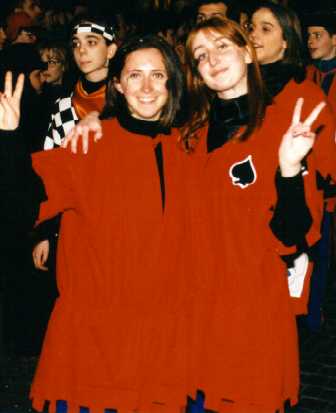 (LAVARINO - Photos)
|
"SABATO
GRASSO" (Carnival Saturday)= at 9.00
pm, a big crowd participates to the presentation of the
"Mugnaia". She comes introduced from the
"Sostituto Gran Cancelliere" at the Civic
Palace's balcony. Now is entered in the Carnival.
Historical figures and the "aranceri", between
fireworks and torches, parades along the roads of Ivrea
and go around starting the celebration in all quarter. SUNDAY =
the distributions of the "fagioli grassi"
(beans in a Piedmontese typical souce) in the
"fagiolata del Castellazzo".
On the "Ponte Vecchio"(the old bridge of the
town) the "Podestà" carries out the historical
manifestation of the "Preda in Dora"; the
Podestà throws in the river Dora a stone of Castellazzo
to show scorn to the tyrants of all times. In the
afternoon the Battle of the Oranges begins. The
spectators will have to wear the "Berretto
frigio" (cap frigio).
|
MONDAY =
in the public squares of the historical center, the last spouses
of the quarter to drive into the ground " 'I pic a l'uso antich ": this symbolically gives start to
the diggin to drive the " scarli " into the ground. In
the afternoon the Battle of the Oranges resumes and the
"Mugnaia" and the "Generale" greet on foot
through the aranceri in all each squares.
| TUESDAY =
in the afternoon there is a new paraded to carnival
procession with the last Battle of the Oranges. In the
late afternoon, the prize giving to the best
"aranceri" and team on the waggon. In the
evening the Abbà carry lanterns and torches for the
burning of the " Scarli ": it is a magical show
that cames befor the funeral march of the Carnival where
the "Generale" and the "Stato
Maggiore" drag the swords on the ground. The
carnival ends with the officially supper late at night. The morning of the
"ASHES WEDNESDAY " =
"Mugnaia", "Generale" and procession
with civilian clothes gose to the Borghetto quarter for
the distribution of " polenta and cod " that
symbolizes the end of Carnival.
The carnival finishes
with the famous phrase " Arvedse a giobia a'n ḅt " (See you on Thursday at
1.00pm).
|
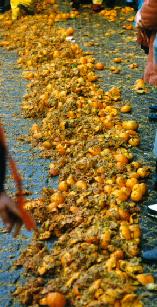 ((Photos by: me!!!!))
|
Orange battle - look the photo
- (Photos
by Bruno de Giusti)
Me and my
sister Monica
- 1997 -
|
- (Photos
by Bruno de Giusti)
La compagnia
di Ventura
- 1997 -
|
TEAM OF "ARANCERI A
PIEDI"
...and for this year
Programm of 2006 edition
Manifesti delle edizioni
Please
write me soon for any error in this page
Write me at: elena.g@infinito.it
Elena
G. - web site © Copyright since 1997 - All rights
reserved
No part of this web site can be used without my written
permission.




